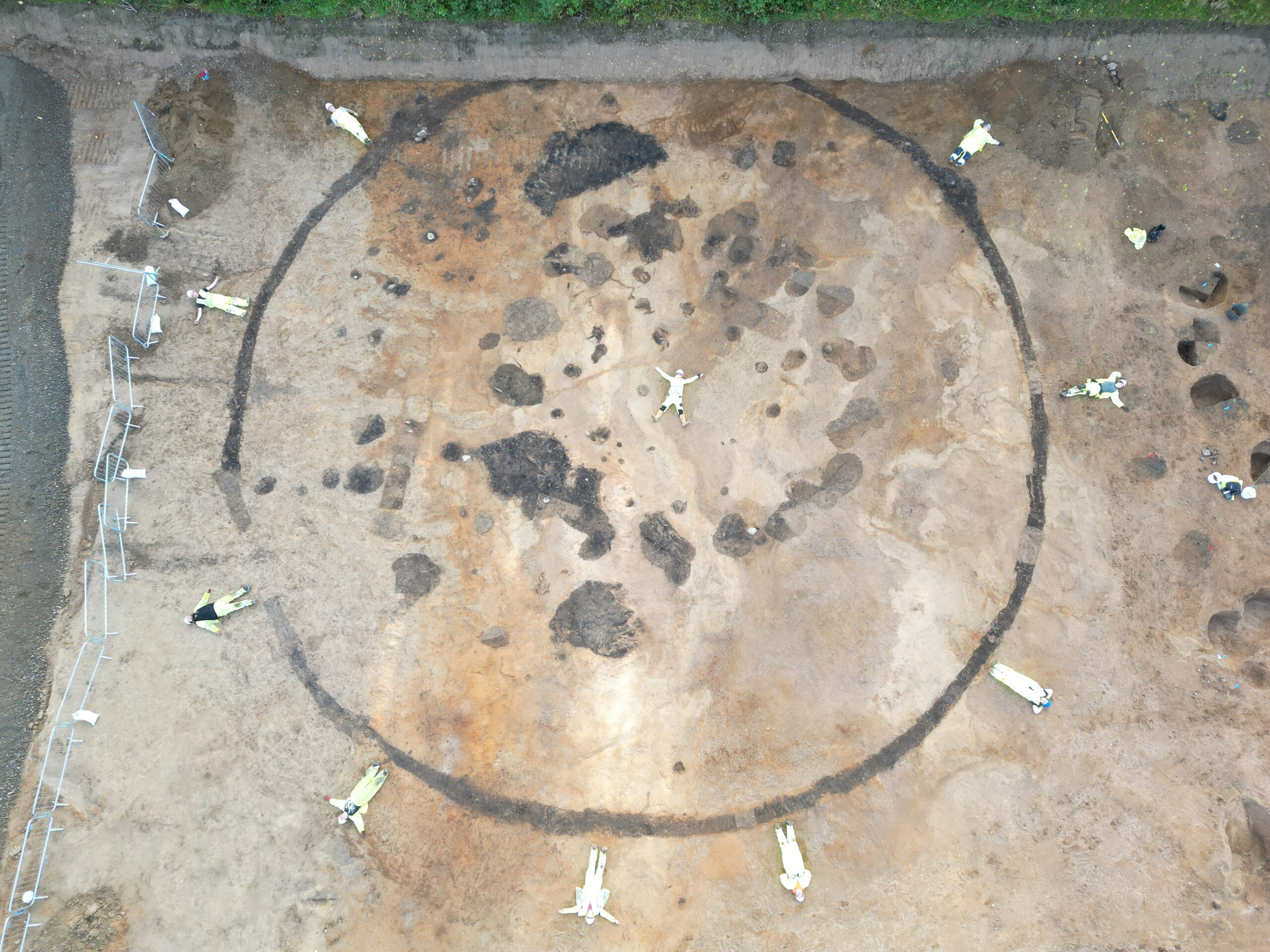Recent excavations ahead of development for HMP Highland have uncovered the remains of roundhouse settlements dating to the Late Bronze Age and Iron Age. The structures found form part of a wider settlement located on the east side of Inverness, which has been revealed piece by piece over the previous three decades during various development works mostly associated with the Inverness Retail Park and the University of the Highlands and Islands Campus.
The archaeological excavation ahead of the construction of His Majesty’s Prison (HMP) Highland at Eastfield Way, Inverness, was carried out between June to November 2022 on behalf of the Scottish Prison Service working alongside Balfour Beatty and UBCivils Ltd.

Reconstructing the Landscape
The above image is an illustration of what the landscape may have looked like when the late prehistoric settlements around Inverness were inhabited. This artistic interpretation was created by using modern Ordnance Survey topology data and adding features such as rivers and forests. We don’t know exactly where these natural features would have been located but the landscape was likely characterised by a mixture of open ground and native woodland. The coastline, particularly around the mouth of the River Ness, was also likely farther south than it is today.
HMP Highland Excavation
Archaeologists uncovered a wide variety of prehistoric remains, including hearth and cooking pits, midden pits, enclosure ditches, and postholes from at least 16 roundhouses and other timber shelters dating to the Iron Age and late Bronze Age occupations. A variety of prehistoric artefacts were found on the site, including metal objects, stone tools such as whetstones and querns, ceramics, and worked flint. Some areas of the site relate to much earlier Neolithic period activity.
The roundhouses survived as circular alignments of postholes, where timber posts had once supported substantial buildings. Circular enclosure ditches defined key areas of the settlement, with two large ditches containing palisade fences that would have protected important roundhouse sites. Another ditch enclosed the remains of an iron-working hearth.
Extensive iron-working activities were found within the roundhouse settlement, with large amounts of charcoal and burnt bone from the processes spread across the area. Three iron ring artefacts were recovered, as well as clay moulds and copper-alloy fragments indicating that specialised casting was taking place. One mould was used for a late Bronze Age leaf-shaped sword – a find that is rare in northern Scottish contexts.
Part of the roundhouse settlement was previously excavated in the late 1990s and produced very similar results to the current investigations, with evidence for iron-smithing and bronze-casting. Two rare Roman brooches were also found, objects that may have been deliberately deposited as offerings. These significant discoveries all point to the HMP Highland site being a local power centre with inhabitants of elite status.
explore 3D models of the metalworking artefacts⚬
explore 3D models of the metalworking artefacts⚬
explore 3D models of the metalworking artefacts⚬
explore 3D models of the metalworking artefacts⚬
explore 3D models of the metalworking artefacts⚬
This burnisher or cushion stone was recovered from a pit that contained metal-working waste and a high quantity of charcoal. Such artefacts are often associated with metal-working, where they would have been used for shaping sheet metals of copper-alloy or precious metals such as gold. The highly polished surface is necessary for planishing metal to avoid leaving tool traces. Such artefacts have been found in settlements, funerary contexts, hoards, and as single finds from Bronze Age contexts across Europe.
Evidence for bronze smithing has been found during several of the excavations on and around the HMP Highland site in the form of clay mould fragments. These mould fragments give an amazing insight into the objects people were creating here during the Late Bronze Age. The presence of the moulds indicates that bronze casting, a skilled and potentially high status craft, was taking place in the area.
The mould fragments from the HMP Highland site would have been used to cast a bronze leaf-shaped sword, a blade with a curved profile. The hole visible on one side would have housed a wooden split used to reinforce the clay and prevent it from warping during the casting process.
A rare clay mould for casting bronze rings, which is the only known example found in Britain and Ireland, was also found in the adjacent field at the site of the UHI campus. The mould comprises an intact valve of a bi-valve mould and may have been associated with the production of small Late Bronze Age penannular rings, often referred to as ‘ring money’ or ‘hair rings’.
The mould would have been one of a pair, which fitted together to create the full mould for the rings. A short conical funnel can be seen at the top, which would have allowed the molten metal to be poured inside, filling the two ring-shaped voids and casting both rings simultaneously. The heat-affected condition of the clay and evidence of some vitrification indicates that the mould had been used.
Parts of the Puzzle
The City of Inverness stands at the mouth of the River Ness on the Moray Firth coast. While the modern town is centred on the medieval Royal Burgh, established in the 12th century, elements of earlier prehistoric settlements are known in various locations around the city. Together, these excavations help to build a picture of late prehistoric Inverness.
The Iron Age hill fort of Craig Phadrig overlooks Inverness from the west and may have been the seat of power in the area. Evidence of roundhouse settlement has been found at nearby Torvean, suggesting a domestic settlement was located beside the river. To the south of Inverness, another cluster of Iron Age roundhouses found at Culduthel contained workshops and furnaces for the specialised production of iron, bronze and glass, indicating that this was a major craftworking centre.
The roundhouse settlement unearthed at the new prison site is just one part of a larger late prehistoric settlement on the east of Inverness, located near the Moray Firth coast. The new discoveries add to the findings of previous excavations at Seafield, Beechwood and the University of the Highlands and Islands (UHI) Campus, which uncovered at least twelve roundhouses, other small structures, and metalworking evidence.
While most of the roundhouse structures discovered were built during the Iron Age (800 BC – AD 400), all the settlements also contained significant evidence for earlier Bronze Age (2500 – 800 BC) and Neolithic (4000 – 2500 BC) activity, indicating a long tradition of human activity in these areas.































